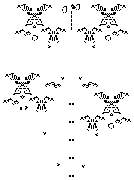Moving sawtooth
Moving sawtooth is an orthogonal sawtooth with expansion factor 3 that was found by David Bell on July 10, 2005. Its minimum infinite repeating population is 1239, and it is notable because it and its slight modifications are the only known sawtooths that move.
| Moving sawtooth | |||||||
| |||||||
| View static image | |||||||
| Pattern type | Sawtooth | ||||||
|---|---|---|---|---|---|---|---|
| Number of cells | 1239 | ||||||
| Bounding box | 128×173 | ||||||
| Expansion factor | 3 | ||||||
| Discovered by | David Bell | ||||||
| Year of discovery | 2005 | ||||||
| |||||||
The pattern works by using the output of c/3 rakes to ignite the blinkers from a blinker puffer 1 (which moves at c/2), with the number of blinkers to be consumed growing in each cycle. Once ignited, the blinker fuse burns at 2c/3.
Image gallery
 The number of alive cells plotted versus the number of elapsed generations roughly forms an ever-increasing sawtooth graph.
The number of alive cells plotted versus the number of elapsed generations roughly forms an ever-increasing sawtooth graph.
Videos
gollark: Huh? Why?
gollark: That's weird, why not just `disk/key` or something, why a directory then `.lua`?
gollark: Intereßting...
gollark: Oh, you're using a keycard door thing?
gollark: Some sort of direct computer-to-computer modem would give people unrealistic ideas about security.
See also
This article is issued from Conwaylife. The text is licensed under Creative Commons - Attribution - Sharealike. Additional terms may apply for the media files.
